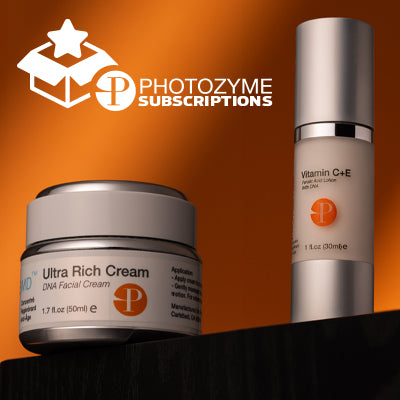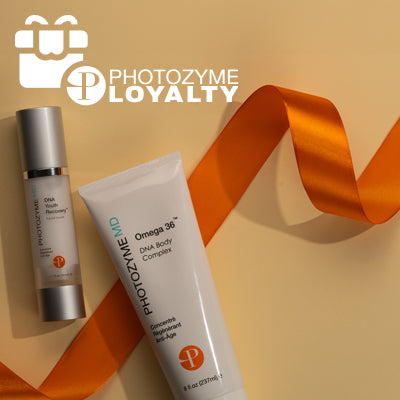
Learn whether glycolic acid vs. salicylic acid best suits your skin's needs and enhance your skincare routine with expert guidance from Photozyme.
Key Takeaways:
- Glycolic Acid: Best For Dry Or Aging Skin: Glycolic acid is ideal for dry or aging skin. It focuses on surface-level exfoliation and enhances cellular turnover for a brighter complexion.
- Salicylic Acid: Ideal For Oily Or Acne-Prone Skin: Salicylic acid helps manage oiliness and acne, effectively penetrating pores to clear blockages and calm inflammation, making it perfect for oily or acne-prone skin.
- Personalized Selection Based On Skin Needs: Understanding your skin's unique needs and tolerances is crucial when choosing between these acids, with careful consideration of seasonal adjustments and potential sensitivity.
Photozyme exists at the forefront of dermatological innovation. Every formula is anchored in patented DNA repair technology and supported by peer-reviewed clinical data. Trusted by skin professionals, our products are precision-formulated to target molecular damage, visibly correct signs of aging, and reinforce long-term skin health. We translate science into performance, engineered for results you can measure on the skin and under the microscope.
When comparing glycolic acid vs salicylic acid, both are clinically validated exfoliants, but they operate on different layers of the skin and target distinct concerns. The key is knowing how they interact with oil production, pore congestion, and texture irregularities. Choosing the right acid means aligning function with formulation, without compromising skin barrier health.
In this blog, we’ll examine how glycolic acid and salicylic acid differ in mechanism, skin compatibility, and clinical use cases, clarifying the exfoliant that aligns with your skin’s goals.
Molecular Size Matters: Penetration Depth Of Each Acid
The effectiveness of an exfoliating acid depends on its molecular size, which is crucial in how deeply it penetrates your skin.
Glycolic Acid Targets Surface-Level Concerns
Glycolic acid, the smallest Alpha Hydroxy Acid (AHA), has a low molecular weight that allows it to move swiftly into the upper layers of your skin. Because of this, glycolic acid primarily works on the surface, breaking down bonds between dead skin cells and encouraging gentle shedding. You’ll notice improved texture and radiance on the outermost layer, making glycolic acid a wise choice if your main concerns are surface-level dullness or uneven tone.
Salicylic Acid Reaches Deep Into The Pores
Salicylic acid, on the other hand, is a Beta Hydroxy Acid (BHA) with a slightly larger and oil-soluble molecular structure. This unique trait lets it travel deeper through your pores, dissolving the excess sebum and impurities that can lead to breakouts and clogged pores. If congestion, blackheads, or blemishes are on your radar, salicylic acid’s deeper-reaching action can help keep pores clear and visibly refined, perfect for oily and combination skin types.
Ideal Skin Types For Glycolic Acid vs. Salicylic Acid
Understanding your skin’s unique attributes is key to making an informed choice between glycolic and salicylic acids. Both exfoliants serve vital roles, but their mechanisms and benefits differ considerably.
Why Glycolic Acid Works For Dry Or Aging Skin
Its small molecular size makes it especially effective at dissolving dead skin cells and boosting cellular turnover. If you have normal to dry skin that feels dull or shows signs of hyperpigmentation, fine lines, or early photodamage, glycolic acid could offer notable benefits. Its hydrophilic nature helps attract moisture, making it less likely to dry out skin compared to some alternatives. Those with mature skin often prefer glycolic acid for its resurfacing and brightening effects.
Why Salicylic Acid Supports Oily Or Acne-Prone Skin
Salicylic acid is oil-soluble, allowing it to penetrate deep into pores and clear out sebum and debris, a critical advantage if you have combination, oily, or acne-prone skin. Salicylic acid not only refines skin texture but also reduces the risk of clogged pores and breakouts. It’s often recommended for those who struggle with blackheads, enlarged pores, or inflammation, as it calms redness while targeting the underlying source of congestion.
How To Approach Sensitive Or Reactive Skin
If your skin is sensitive, consider patch testing or reaching for lower acid concentrations. Sensitive complexions can react to AHAs and BHAs, so gradual introduction and mindful observation are essential. For those with persistent redness, visible capillaries, or rosacea, caution is warranted, as any active acid can potentially increase irritation.
Seasonal Adjustments For Chemical Exfoliation
The needs of your skin change throughout the year, and so should your approach to chemical exfoliation. Both glycolic acid and salicylic acid interact with environmental factors like temperature, humidity, and sun exposure, meaning the right formula, frequency, and application method may shift with the seasons.
How Cold Weather Alters Exfoliation Needs
During colder months, your skin barrier becomes more vulnerable due to lower humidity and increased indoor heating. This can amplify dryness and sensitivity, especially when using higher-concentration exfoliants. In winter, consider reducing the frequency of application, choosing lower concentrations, or supplementing with gentle hydrating products. Salicylic acid, with its oil-regulating properties, can help manage the occasional buildup from richer moisturizers but may require offsetting with intensive hydration.
Why Warm Weather Requires Extra Precautions
As temperatures rise in spring and summer, increased humidity can keep skin more pliable, and you may find glycolic acid especially effective for promoting even tone and clarity. However, glycolic and salicylic acid increase photosensitivity, so daily broad-spectrum sunscreen is non-negotiable. If you spend more time outdoors, consider exfoliating in the evenings and monitoring for any signs of irritation.
The Importance Of Monitoring Skin Feedback Year-Round
No matter the season, listen to your skin. Signs of overexfoliation, redness, stinging, or persistent flaking mean it’s time to scale back and prioritize barrier repair. With thoughtful seasonal adjustments, chemical exfoliation remains a powerful tool for promoting skin health, radiance, and resilience year-round.
Layering With Retinoids, Vitamin C, And Sunscreen
Following an advanced skincare routine means understanding which actives to choose and how to combine them safely and effectively.
- How To Alternate Retinoids & Acids: Using glycolic or salicylic acid and retinoids on different nights to avoid overstimulation. This alternation supports skin barrier function and minimizes peeling, making the actives more tolerable without compromising their cumulative effects on tone, clarity, or firmness.
- When To Apply Vitamin C In The Routine: Vitamin C pairs well with exfoliating acids in the morning. Apply it after cleansing and before sunscreen to neutralize free radicals and reduce pigmentation. It works synergistically with overnight exfoliation for a brighter, more even complexion.
- Why Sunscreen Is Essential Every Day: Acid exfoliation increases photosensitivity, making skin more prone to UV-induced damage. Use broad-spectrum SPF every morning, even on cloudy days. This step safeguards newly exposed skin layers and prevents the reversal of any progress achieved with exfoliants and retinoids.
- How To Respond To Skin Discomfort: Persistent redness, flaking, or stinging signals overuse or incompatibility. Reduce the frequency of active products and increase hydration support. Building a responsive routine around barrier needs helps you adjust protocols without halting the benefits of acid-based or retinoid treatments.
- How To Sequence Your Products For Results: Layer actives from thinnest to thickest. In the morning, start with a cleanser, toner (if used), vitamin C, or serum, moisturizer, and sunscreen. At night, alternate exfoliants and retinoids with appropriate hydrators in between.
Signs You Need To Switch Or Alternate Acids
Choosing chemical exfoliants can be overwhelming, but your skin will offer clear signals if your current choice of glycolic acid or salicylic acid isn’t meeting its needs. Attention to these signs can help you refine your routine for optimal results.
1. Persistent Irritation Or Dryness
If you’re noticing ongoing redness, flaking, or tightness, it may be a sign that your skin barrier is feeling overwhelmed. Glycolic acid, a powerful alpha-hydroxy acid (AHA), can sometimes cause sensitivity, mainly if your skin tends to be dry or reactive. In this case, alternating with or switching to salicylic acid may provide relief, less likely to disrupt the barrier on certain skin types.
2. Stubborn Breakouts
Breakouts that refuse to budge even with consistent use of glycolic acid indicate it might not target the root of the issue. Glycolic acid is known for addressing surface-level texture and pigmentation. However, if you’re struggling with clogged pores, blackheads, or inflammatory blemishes, salicylic acid’s beta-hydroxy structure allows it to penetrate and clear pores more effectively.
3. Plateaus In Texture Or Tone
If you no longer see improvements in radiance or smoothness, your skin may have adapted to your current acid. This plateau is a cue to reassess. Rotating or introducing a complementary acid can break through stagnation, like introducing glycolic acid for gentle resurfacing alongside salicylic acid’s clarifying prowess.
4. Increased Sensitivity To Sun
Excess photosensitivity can occur if your exfoliation routine is too aggressive, especially with AHAs such as glycolic acid. If you notice increased redness after sun exposure, evaluate the frequency and concentration of your acids. You can reduce usage or alternate between glycolic and salicylic acid to allow your skin ample recovery time.
Final Thoughts
Choosing between glycolic acid and salicylic acid requires understanding your skin’s needs and equipping yourself with science-backed solutions. Glycolic acid, with its ability to accelerate cellular turnover and even tone, is a powerful option for addressing fine lines and photoaging. Salicylic acid, on the other hand, excels in clearing pores and controlling breakouts, making it indispensable for those prone to congestion and uneven texture.
At Photozyme, we believe that proper skin health stems from a foundation of professional ingredients and innovative DNA repair technology. Pairing purposeful acids with our advanced, clear skin Probiotic Cleanser amplifies your results, helping safeguard your skin against sun-induced damage while restoring resilience and radiance.
Every routine is unique, and your skin evolves. Evaluate its current condition and long-term goals, and trust clinically validated formulations to help get your healthiest complexion. Science is on your side, and with Photozyme, you have a partner deeply invested in your skin’s ongoing recovery and protection.
Read also:
- Adapalene vs. Retinol: Which One Is Right For Your Skin?
- Bakuchiol vs. Retinol: A Gentle Alternative Or Just Hype?
- Retinol + Vitamin C: Power Duo Or Recipe For Irritation?
Frequently Asked Questions About Glycolic Acid vs. Salicylic Acid
What is salicylic acid?
Salicylic acid is a beta-hydroxy acid (BHA) that penetrates deep into pores to dissolve excess oil and dead skin cells. This oil-soluble exfoliant is well-known for unclogging pores, reducing breakouts, and minimizing visible blemishes. Because it is anti-inflammatory and soothing, you’ll often find it in formulations designed for acne-prone and oily skin types.
How do glycolic acid and salicylic acid differ?
Glycolic acid is an alpha-hydroxy acid (AHA) derived from sugar cane. It primarily exfoliates on the skin’s surface, helping to reduce dullness, fine lines, and pigmentation. On the other hand, salicylic acid is a BHA that can travel into oily pores, making it more effective for deep cleansing and targeting acne. Glycolic acid increases skin cell turnover and brightens, while salicylic acid clears pores and calms inflammation.
Which acid is better for oily skin?
Salicylic acid is a clear winner for oily skin. Its oil-soluble nature enables it to penetrate and clear congested pores, making it highly effective for managing excess sebum and preventing breakouts. Salicylic acid is your ally if your main concerns are shine, enlarged pores, or recurring blemishes.
Which acid is better for dry skin?
Glycolic acid is typically preferred for dry skin. By removing surface-level dead skin cells and encouraging cell renewal, glycolic acid helps your skin absorb moisture and radiate with a smoother texture. It can be hydrating if formulated correctly and is often used to address dry patches, rough texture, and visible signs of aging.
Is salicylic acid good for acne-prone skin?
Absolutely. Salicylic acid’s pore-penetrating ability and anti-inflammatory properties make it a cornerstone ingredient for acne-prone complexions. When used as directed, it helps reduce breakouts, blackheads, and clogged pores without causing excessive dryness.
Can I use glycolic acid and salicylic acid together?
You can use both acids in a routine, but it’s essential to introduce them gradually and monitor your skin for irritation. Layering or alternating their usage can harness glycolic acid's surface-smoothing benefits with salicylic acid's pore-clearing power. Always prioritize hydration, sun protection, and products that repair skin, like Photozyme’s DNA Youth Recovery Facial Serum, when using active exfoliants.
What are the side effects of salicylic acid?
Potential side effects include dryness, redness, slight stinging, or peeling, especially if your skin is sensitive or used excessively. Salicylic acid is generally well-tolerated, but always start with lower concentrations and follow up with nourishing, protective skincare to restore balance.
Which acid is better for anti-aging?
Glycolic acid is often favored for anti-aging. Its ability to stimulate cell turnover, fade age spots, and refine texture makes it valuable for addressing fine lines, wrinkles, and pigmentation. Paired with DNA repair technologies, like those in Photozyme’s formulations, you can target surface damage and underlying molecular changes for a visibly revitalized complexion.





